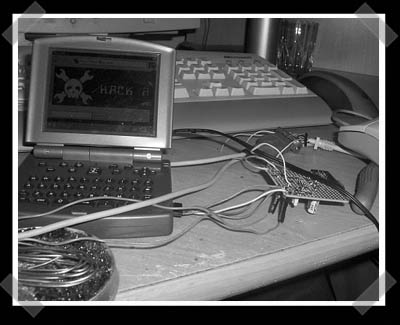
[karosium] sent in this one. He(?) put in alot of effort on this one. After flashing the EEPROM on the ZipIT he got the PIXIL embedded linux distro running on the ZipIT. It’s a work in progress, but the web browser works. Even if you don’t have a ZipIT, it’s worth checking out. There’s mention of building a PLCC32/DIP32 flasher built from an old PII. Great work!
handhelds hacks424 Articles
Newton Web Server

[Ian] sent in this Newton web server. [The page is served by the newton, I doubt it’ll handle our load] Apparently there’s still a good following for the handy message pads. (I really wanted a 120 when they came out) This one’s running newton personal data sharing to deliver its web interface.
GP2X GPS
Hack-a-day favorite [Sprite_tm] sent in another nice GP2X hack. He knew he had some space from his previous USB port adventure. He pulled a small reciever from a cheap SDIO GPS card and added it to his GP2x. He rounded it out with an ATTiny13 that’s used to power up the GPS only after it recieves a magic string from the onboard serial port.
GP2X With Built In USB Host Port

Hacker [Sprite_tm] is one of our favorites. He continues to court our fancy with his latest hack, adding a USB host port to his GP2X. The GP2X is a Linux based handheld game system. It supports USB devices through its EXT port. Problem is: it doesn’t provide power and you have to use a dongle. The GP2X uses a MAX1566 DC-DC converter so Sprite_tm was able to get 5V from the chip that was otherwise unused. Once mounted in place all he needed to do was write a simple script to mount the USB device. The chip should provide 500mA, but it’s not guaranteed. High draw could lock up the GP2X so a powered hub should still be used if you are unsure.
CCFL Backlight Replaced With White LEDs

[Jeroen Domburg], one of our favorite hackers, has posted how to replace a cold cathode based backlight with white LEDs. He had recently purchased an HP Jornada 680 on eBay and the backlight was looking very pinkish. The Jornada has a QWERTY keyboard, CF slot, PCMCIA slot and can run Linux. Sounds like a pretty decent mini-terminal (now that we posted it you won’t be able to find one cheap though). In the space where the backlight was he was able to place 14 white LEDs. To get the 40V necessary to drive the series he built a boost-converter using an ATTiny13. The new backlight is just as bright and uses a 1/3 less power than the original. Half the Jornada’s power was being used by the original backlight, so this mod should give a decent increase in battery life as well.
Qtopia On The GP2X

Trolltech’s Qtopia is the application platform/user interface of choice of Linux handheld device manufacturers. It doesn’t matter if it’s a phone, PDA, or single application device. Hacker NK has successfully ported the GUI to the GP2X. With USB host mode,he’s been able to surf the web with Opera while using a full keyboard, mouse and WiFi adapter. The Sharp Zaurus PDA uses Qtopia with an ARM processor too and users have reported success pulling applications from the Zaurus software repository and running them on the GP2X. Here are some photos of the action one and two.
UPDATE: Commenters say that the GP2X forums have a Windows trojan. I think you’ll be fine if turn off Java.
[thanks omarnawaz]
Palm Zire 71 Resurrection

Reader [steve diraddo]’s Zire 71 had given up the ghost long ago, but with a strong desire to annoy his friend, he decided to resurrect it. Unfortunately, like most things that rise from the earth to feast on the brains of the living, Steve’s Zire has limited capacities. When he had originally disassembled the device it was because the camera had stopped functioning, it couldn’t sync, and failed to charge. If he was going to do anything with the device, he would need to get it charging again. The dock connector no longer worked, so he grabbed the pinout for the internal connector from pinouts.ru. By following the traces, he was able to solder a USB cable directly to the board and start the device charging. There are also narrow USB data lines on the board, but Stave didn’t trust his hands to solder them. Programs can still be loaded via IrDA or the SD card. Plugging the screen back in and loading up NoviiRemote he had an ugly, but still very functional toy-to-annoy.
On a related note, [Radu Privantu] sent along his write up: How to use a Pocket PC with a broken screen. Even though it doesn’t have a screen you could still use it as a thin client for streaming music, as a skype phone, a WiFi camera, or a dedicated development platform.











